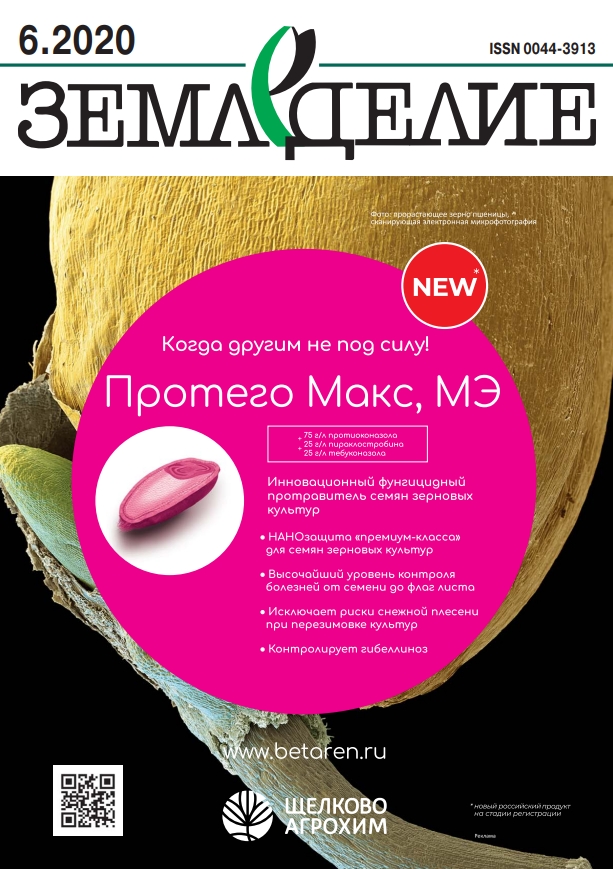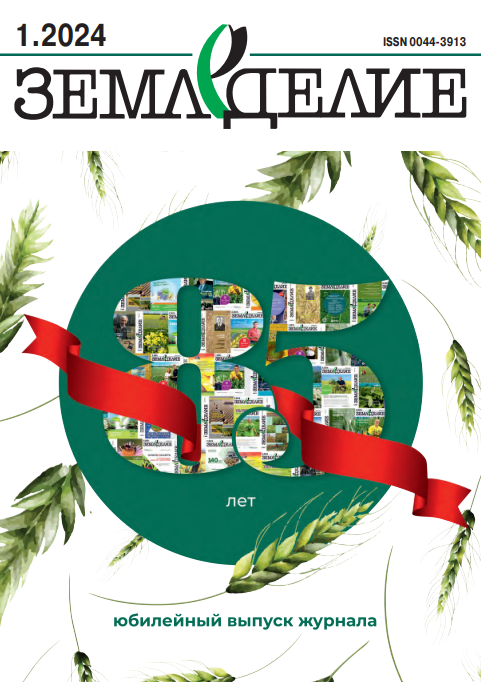Содержание гумуса в выщелоченном черноземе в зависимости от севооборота, системы обработки почвы и удобрений в лесостепи юга Западной Сибири
doi: 10.24411/0044-3913-2020-10604
УДК 631.417.2: 631.582: 631.51: 631.84/.85
В. И. УСЕНКО, доктор сельскохозяйственных наук, главный научный сотрудник (e-mail: Адрес электронной почты защищен от спам-ботов. Для просмотра адреса в вашем браузере должен быть включен Javascript.)
С. В. УСЕНКО, кандидат сельскохозяйственных наук, ведущий научный сотрудник
Т. А. ЛИТВИНЦЕВА, кандидат сельскохозяйственных наук, старший научный сотрудник
Федеральный Алтайский научный центр агробиотехнологий, пос. Научный городок, 35, Барнаул, 656910, Российская Федерация
Исследования проводили с целью изучения влияния севооборота, системы обработки почвы и удобрений на содержание гумуса в выщелоченном среднемощном среднесуглинистом черноземе. Работу выполняли в Алтайском крае в стационарном многофакторном полевом опыте со следующей схемой: севооборот (А) – бессменная пшеница, полевой севооборот; обработка почвы (В) – без обработки (No-till), мелкая плоскорезная на 14…16 см, глубокая плоскорезная на 25…27 см; удобрения (С) – без удобрений, аммофос при посеве, аммиачная селитра до посева (под горох – аммофос) + аммофос при посеве. Содержание гумуса (по Тюрину) в пахотном (0…20 см) слое почвы составляло 3,80 %, подвижного (по Чирикову) фосфора и калия – соответственно 200 и 180 мг/кг. Содержание гумуса определяли в образцах почвы, отобранных в пахотном (0…20) и подпахотном (20…40 см) слоях в 2019 г. после трех ротаций в заключительном поле севооборота, и под бессменной пшеницей. Варьирование величины этого показателя в пахотном слое почвы определяется влиянием севооборота (42,7 %) и обработки почвы (38,0 %), в подпахотном – преимущественно севооборотом (66,0 %) и меньше (17,0 %) обработкой почвы. Отказ от севооборота при переходе к бессменной пшенице сопровождается снижением содержания
гумуса в пахотном и подпахотном слоях почвы с 4,19 до 3,70 % и с 3,89 до 3,18 % соответственно, а замена глубокой на мелкую и нулевую обработки – его увеличением с 3,65 до 3,95 и 4,22 % и с 3,28 до 3,66 и 3,66 %. Влияние обработки на содержание гумуса в пахотном слое под культурами севооборота было сильнее, чем в подпахотном и под бессменной пшеницей. Удобрения не оказывали существенного влияния на содержание гумуса в почве.
Ключевые слова: содержание гумуса, севооборот, бессменный посев, обработка почвы, прямой посев, удобрения.
Для цитирования: Усенко В. И., Усенко С. В., Литвинцева Т.А. Содержание гумуса в выщелоченном черноземе в зависимости от севооборота, системы обработки почвы и удобрений в лесостепи юга Западной Сибири // Земледелие. 2020. № 6. С. 18–21. doi: 10.24411/00443913-2020-10604.
Humus content in leached chernozem depending on crop rotation, soil treatment system and fertilizers in the foreststeppe of the South of Western Siberia
V. I. Usenko, S. V. Usenko, T. A. Litvintseva
Federal Altai Scientific Center of Agrobiotechnologies, Nauchnyi gorodok, 35, Barnaul, 656910, Russian Federation
Abstract. We study the influence of crop rotation, soil treatment systems and fertilizers on the content of humus in leached mediumthick medium-loamy chernozem. The work was performed in the Altai Territory in a stationary multi-factor field experiment with the following design. Factor A was crop rotation: permanent wheat, a field crop rotation. Factor B was soil treatment: without treatment (notill), shallow blade cultivation at 14–16 cm, deep blade cultivation at 25–27 cm. Factor C was fertilizer: without fertilizers, ammophos during seeding, ammonium nitrate before seeding (ammophos for pea) + ammophos during seeding. The humus content (according to Tyurin) in the arable (0–20 cm) soil layer was 3.80%, the content of mobile phosphorus and potassium (according to Chirikov) – 200 and 180 mg/kg, respectively. The humus content was determined in soil sampled from the arable (0–20) and subsurface (20–40 cm) layers in 2019 after three rotations in the final crop rotation field and under permanent wheat. The variation in the value of this indicator in the topsoil is determined by the influence of crop rotation (42.7%) and tillage (38.0%), in the subsoil – mainly by the influence of crop rotation (66.0%) and to a lesser degree – by tillage (17.0%). Refusal of crop rotation during the transition to permanent wheat is accompanied by a decrease in the humus content in the arable and subsoil layers from 4.19 to 3.70% and from 3.89 to 3.18%, respectively, and the replacement of deep cultivation by shallow one and no-till is accompanied by its increase from 3.65% to 3.95% and 4.22% and from 3.28% to 3.66% and 3.66%. The influence of cultivation on the humus content in the arable layer under crops of crop rotation was stronger than in the subsoil and under permanent wheat. Fertilizers did not have a significant effect on the humus content in the soil.
Keywords: humus content; crop rotation; permanent culture; tillage; direct seeding; fertilizers.
Author details: V. I. Usenko, D. Sc. (Agr.), chief research fellow (e-mail: usenko.001@ mail.ru); S. V. Usenko, Cand. Sc. (Agr.), leading research fellow; T. A. Litvintseva, Cand. Sc. (Agr.), senior research fellow.
For citation: Usenko VI, Usenko SV, Litvintseva TA [Humus content in leached chernozem depending on crop rotation, soil treatment system and fertilizers in the foreststeppe of the South of Western Siberia]. Zemledelie. 2020. (6):18-21. Russian. doi: 10.24411/0044-3913-2020-10604.










